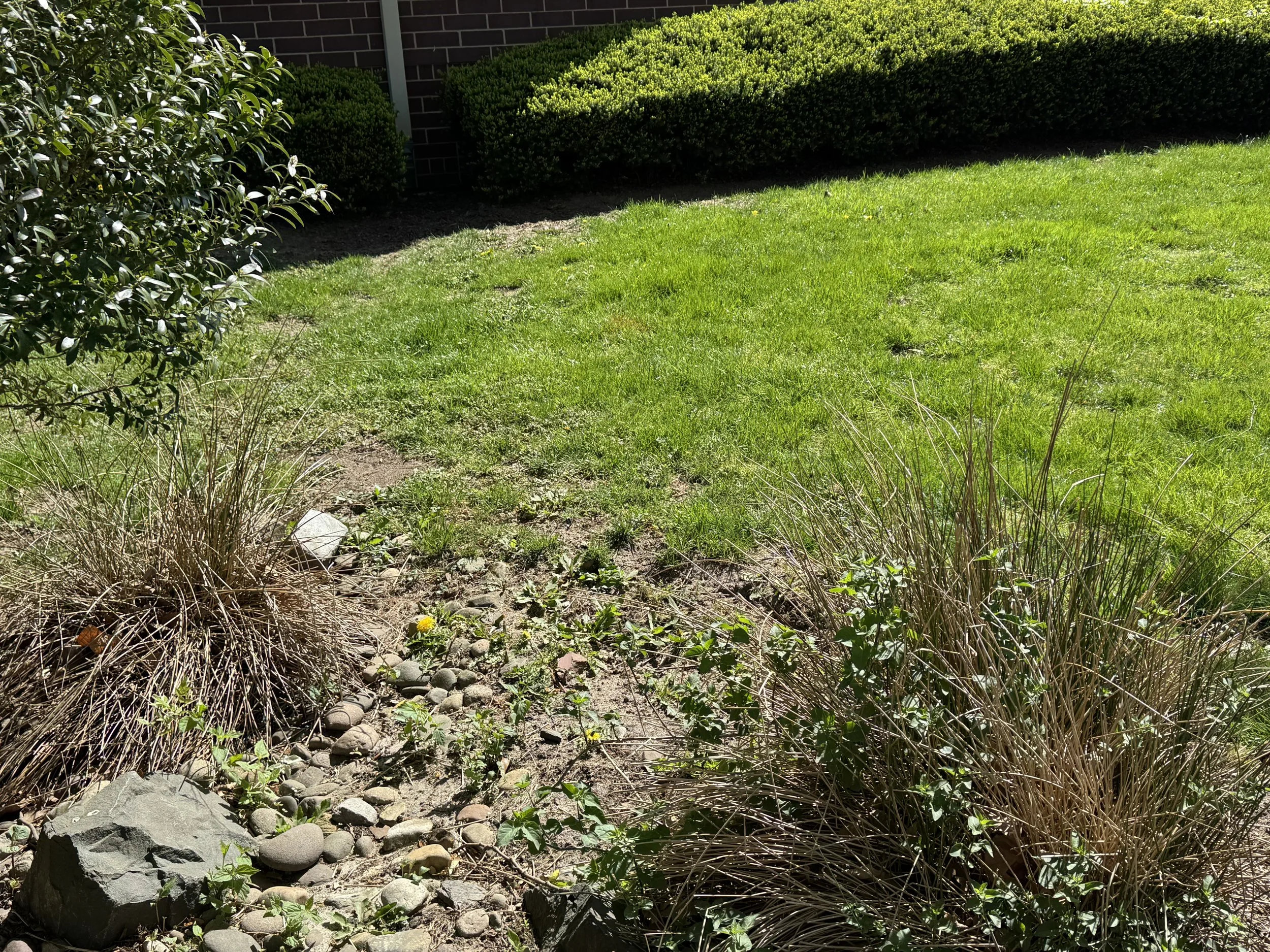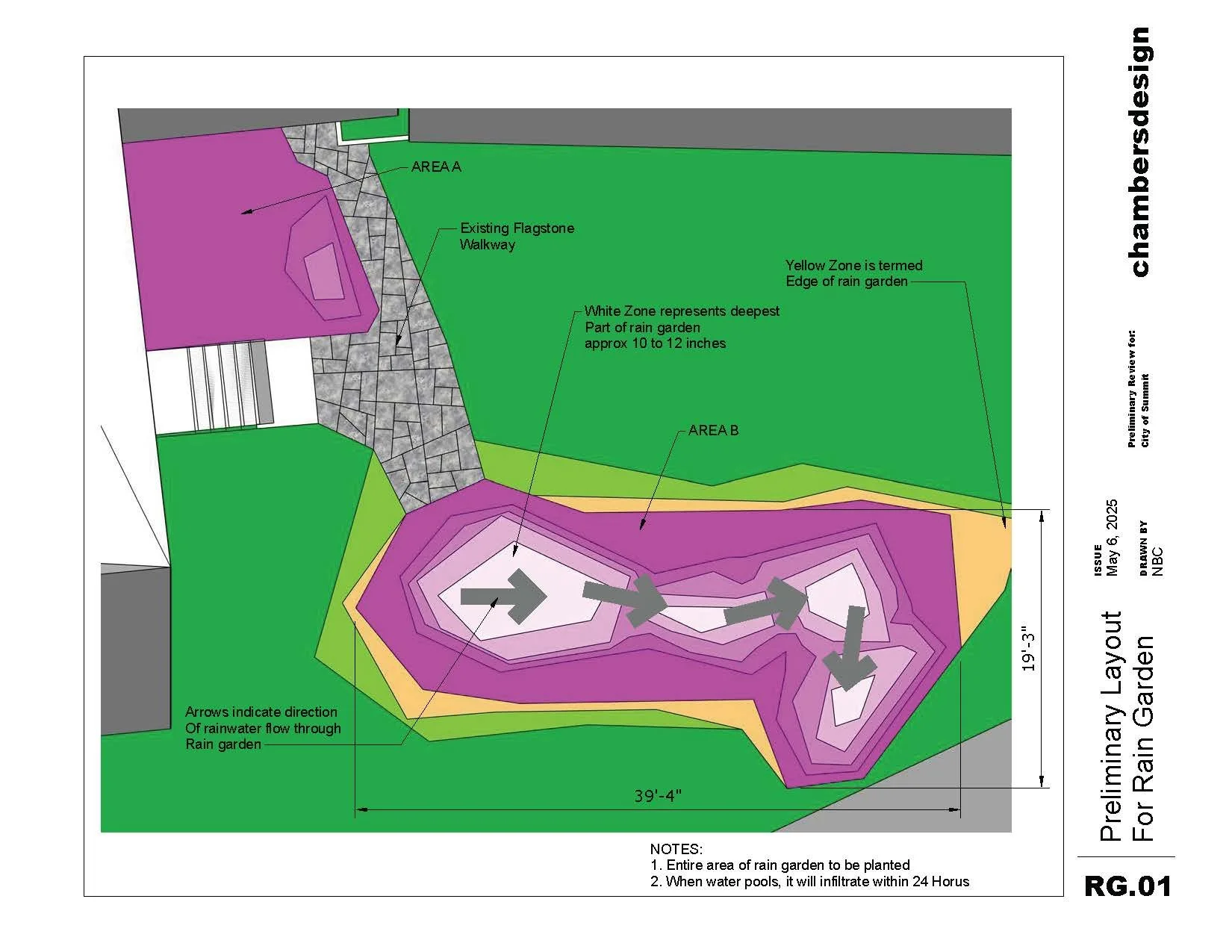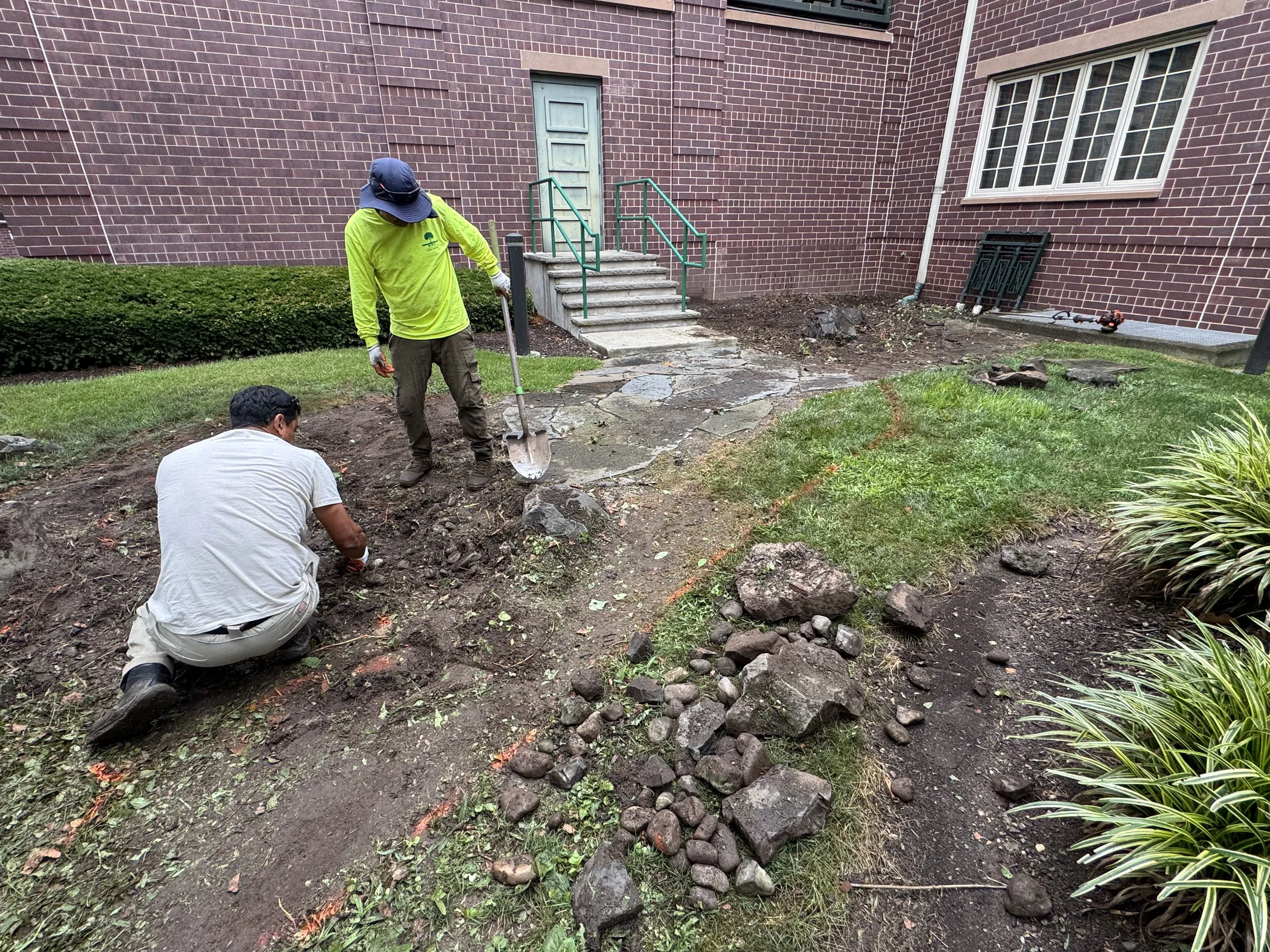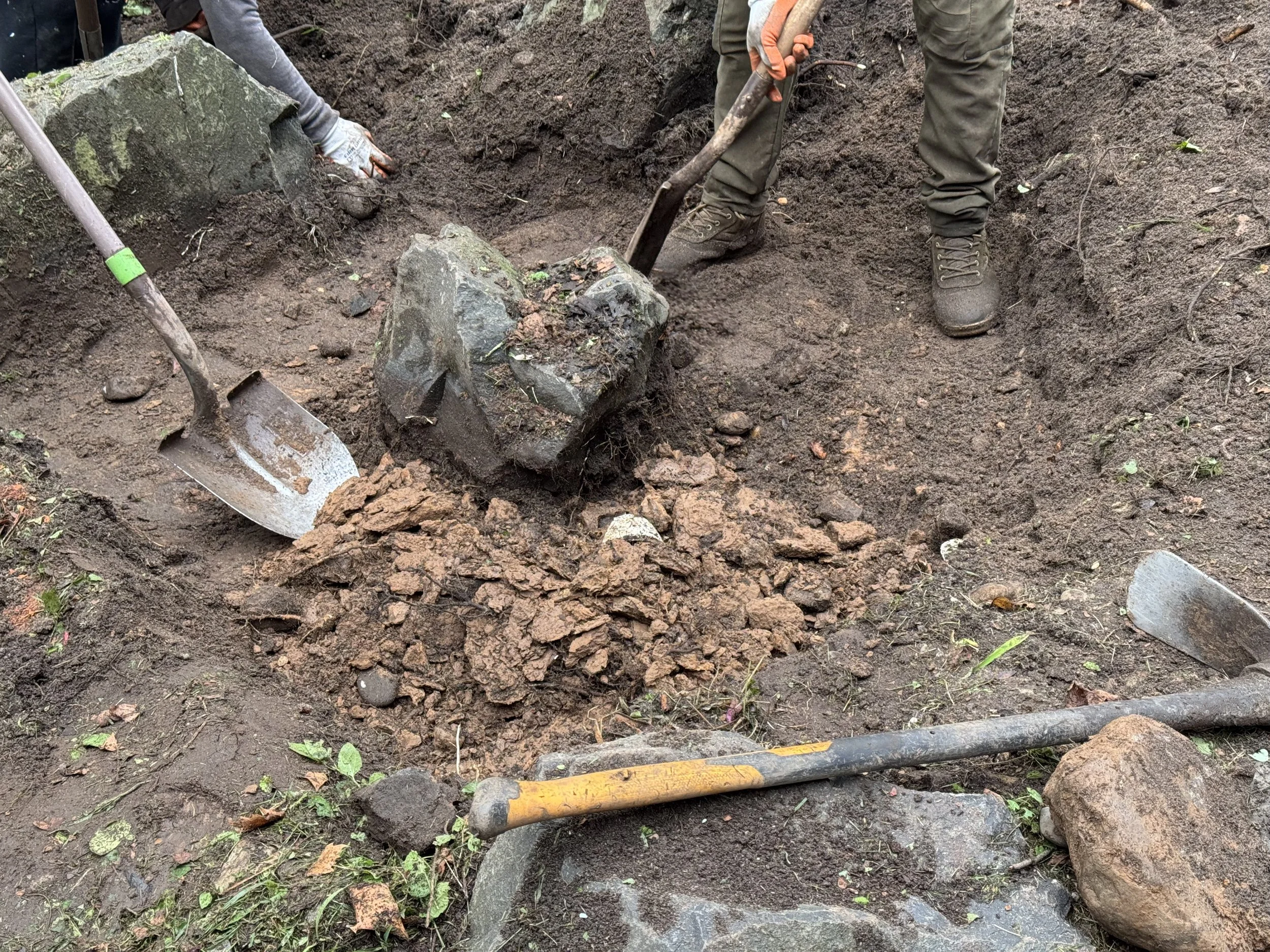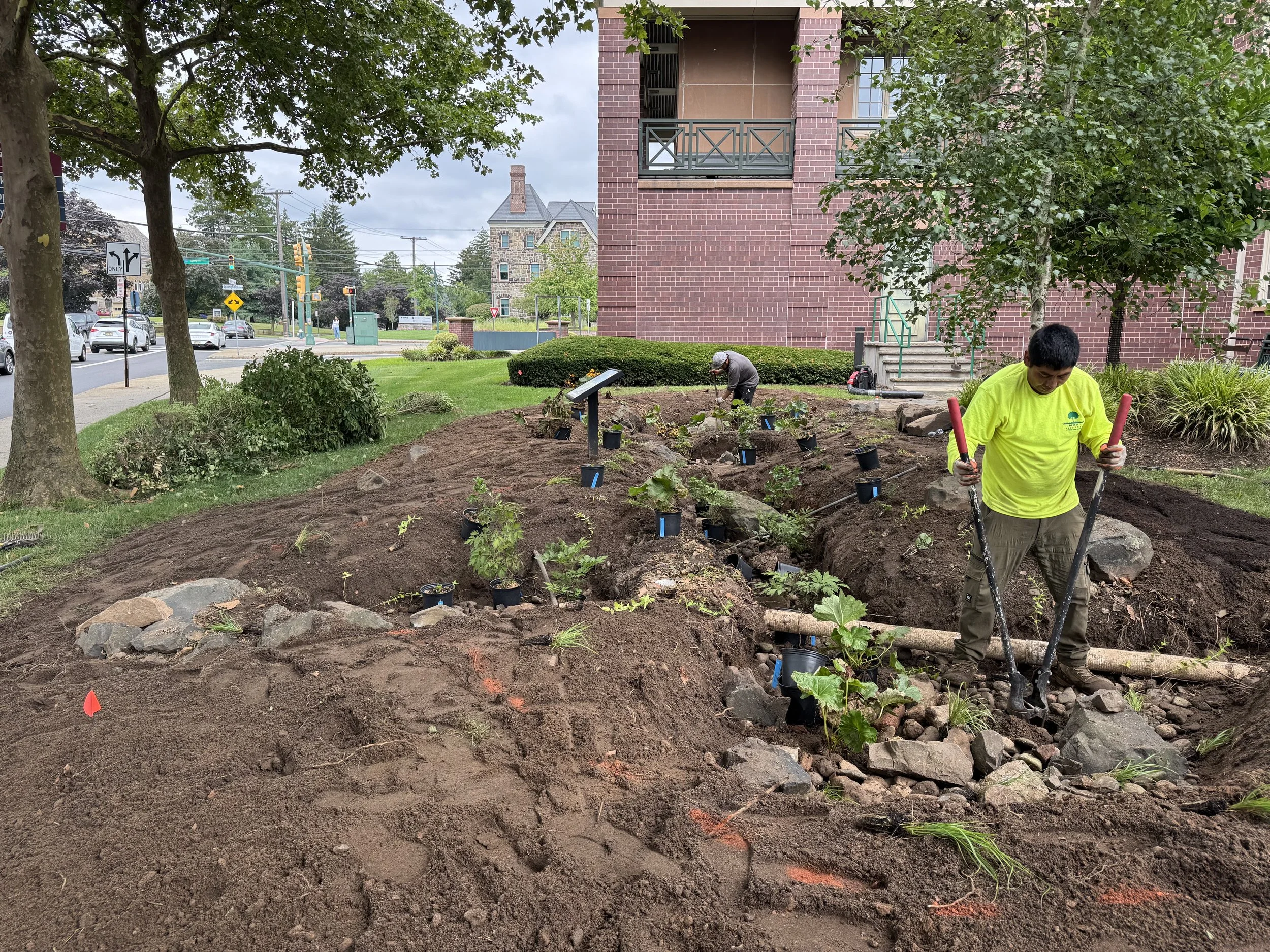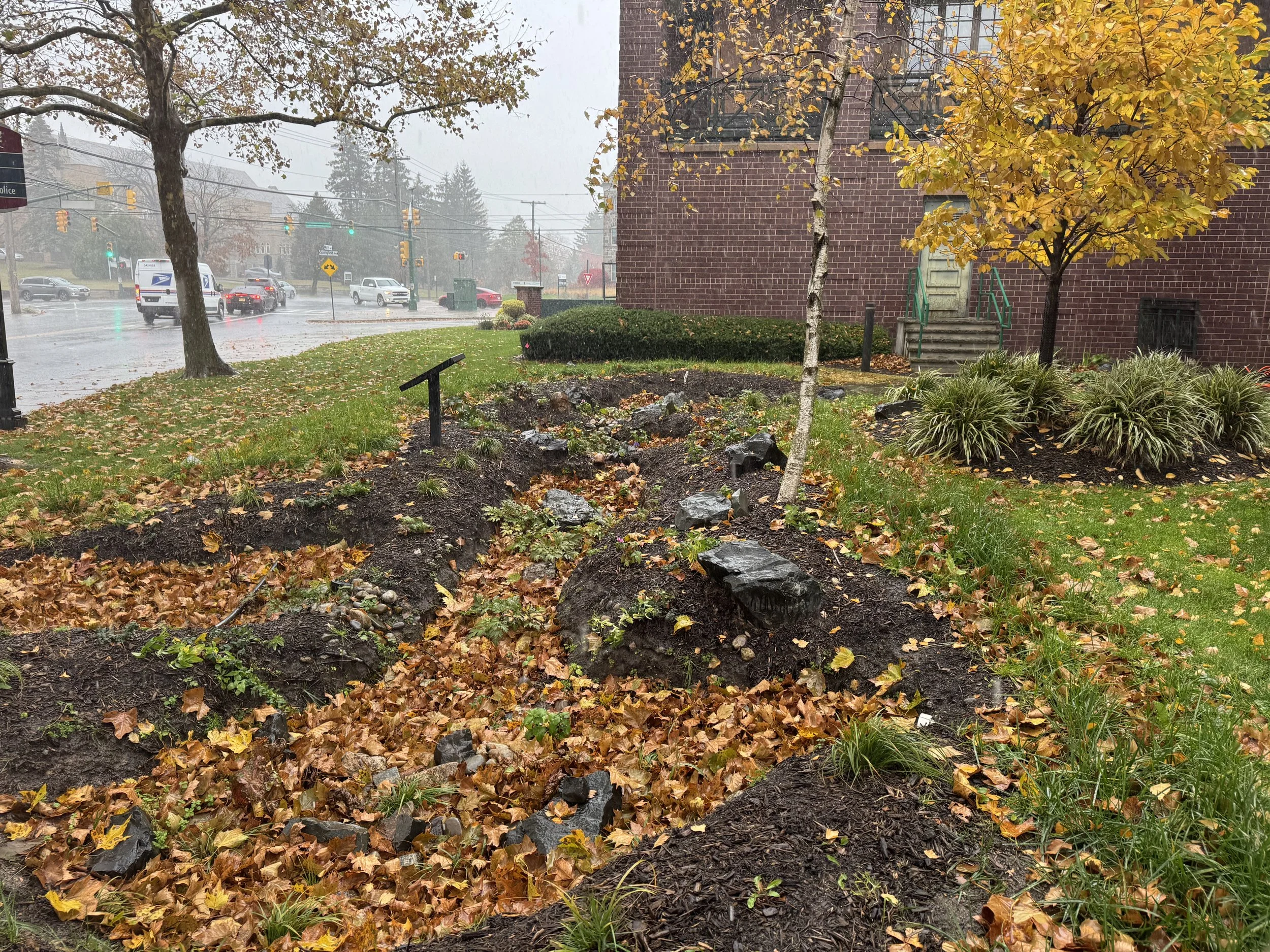Rain Garden for the City of Summit, NJ
Photo by: chambersdesign
This year, we designed, installed, and began to manage a rain garden for the City of Summit in NJ. It’s our first chance to work with them - and it’s been exciting. We first approached the city back in 2024 with GIP-C program. After a little perseverance and a few conversations, a real opportunity emerged. The task was to reimagine an existing rain garden located in the side yard of their city hall property. It has been there for just about a decade. During the last few years it has fallen into disarray. For us, it’s a project that explores how green infrastructure truly making a better civic society.
How It Started
Back in November of 2024, I went by the city hall in Summit, NJ to checkout a rain garden that had been built back in 2016. It was original installed by the Rutgers Cooperative Extension Water Resources Program (RCE) with funding by the Department of the Interior through a grant from the National Fish and Wildlife Foundation’s Hurricane Sandy Coastal Resiliency Competitive Grant Program. From the information on the RCE website, the original design was of a hybrid dry creek/bioswale with a shallow basin to detain stormwater coming off the roof of city hall. In researching the history of the project, I reviewed images of the corner of Morris and Springfield on Google Maps. There, I could see the state of the rain garden from fall of 2016 to summer of 2021. The street views tell a story of blossoming rain garden thriving more and more each season. However, at some point between 2021 and 2024, the garden had taken a turn for the worst. By the time of my visit, the lushness I saw on Google Maps had given way to dead shrubs, invasive knotweed and lots of blank spots where nothing was growing at all.
Photo by: chambersdesign
None of the plants I saw in the images from Google Map or on the RCE website were still present. As you can see from the picture above (taken in April 2025), the surface of the rain garden is covered with a gritty mix of sand and dirt. Only a couple of Juncus effusus (which could be lone survivors from the first plantings) are present. The rest of the plants are an assortment of weeds like dandelions.
Photo by: chambersdesign
From the image above, you can see how the basin has completely disappeared into the surrounding lawn. In some places, the in-fill is actually higher than the lawn.
Renovation
When we set out to design the rain garden for the city hall, we had 2 major goals. First, we want it to be highly functional as green infrastructure. That means, we wanted it to have a large capacity to detain and infiltrate rainwater while filtering that water in the process. Second, we wanted it to be beautiful. Beautiful in the sense that it is visually appealing from near and far away. The site is at a very busy intersection and only steps away from the Summit downtown. This allows it to be seen by many motorists and pedestrians everyday. When I’m onsite, I’m always surprised by all of pedestrians that pass by.
Photo by: chambersdesign
Above is a sketch of the initial design. It extends the footprint of the original rain garden to be a total area of just around 750 sf. We created 4 basins that are separated to allow the rainwater to flow into the structure in a phased approach. Small rains can be completely contained in the first basin while larger storms may fill the entire system. The portion of the roof that feeds the rain garden is approximately 1,620 sf. An average rainfall means more than 1,200 gallons of water drain off the roof. Our design will easily hold 3 times that.
The amount of water moving through the rain garden brings up an important point that seems obvious but might get missed. These types of gardens are not simply a bed of flowers that a standard landscaping crew can manage. It takes a combination of deep botanic knowledge, significant patience with tasks like weeding and a determination to allow the system to continue to improve year after year. Significant training is required both in the subject matter as well as in the field. In visiting dozens of green infrastructure structures throughout Morris, Union and Essex counties constructed between 5 to 10 years ago, I have found only 1 or 2 still in working order. All of the others had become little more than weed factories - or have all but disappeared from bad management.
Because green infrastructure deal with so much water the plants and soil have a tendency to get damaged. Damaged plants die. Damaged soil becomes a nursery for weeds. Where a normal bed always has to deal with airborne seeds from invasive flora. Rain gardens has this threat along with seed in the water column flowing through them. If weeds aren’t properly addressed along with replacing dead plants, the entire system can begin to fall apart. Green infrastructure isn’t really green without using perennials and grasses. This means that a plant will exhibit a full lifespan every year. This spectacular display comes with a need to know how a plant looks at each stage. For example, Echinacea purpurea (coneflowers) is a popular flower that goes dormant in the winter with the stem dying all the way back to the ground. When it starts to reappear in the spring - the leaves look very similar to Plantar major (Broadleaf plantain) which is a weed. If you don’t know the difference, it’s very easy to remove the coneflower thinking you are getting rid of a undesirable weed. The life cycle of plants allow different plants to occupy the same space at different parts of the year. If you aren’t careful, you can cut or mow a patch of weeds that seem to be crowding out everything else. In reality, all you are doing is killing perennials that would easily begin to mature as the spring weeds disappear.
past experience
Patience is a virtue, and I’ve found that my time in the Rain Park has really pressed that home. Very often, it’s necessary to remove weeds by hand. Weed hackers and lawn mowers are just not discerning enough to allow green infrastructure to flourish. This is especially true in small areas - but in larger plots as well. And not only do you need to hand-pull weeds, but you have to move slow and take your time removing weeds slowly so not to accidentally yank something out of the ground that you want to keep. This is partially true for green infrastructure systems that need to be renovated and restored. Often, weeds are well established and nothing short of killing everything would likely eliminate the annoying weeds.
This idea of slow weeding and doing it by hand flies in the face of contemporary attitudes for landscape management. For decades, machines have always been the most convenient option. I’ve tried to manage green infrastructure with this mentality and I’m convinced it greatly reduces the positive benefit of more natural ways of dealing with stormwater. The normal way of do landscaping business will not give New Jersey a well paved path to success with new laws and regulations where green infrastructure is mandated. Seeing is believing. Of the dozens of rain gardens I visited, only 2 were still working well.
INSTALLATION
The installation of the new rain garden was completed in August 2025.
Photo by: chambersdesign
As you can see in the image above, we cleared the area before we started to excavate. We typically don’t use heavy equipment to dig green infrastructure. Large machinery will cause compaction of the soil - and we don’t want that. Compacted soil create several negative impacts - most of all, it limits the rate of infiltration during storms. Even small backhoes and skids can compact the soil. It’s always best to use hand tools during the construction. There were lots of rocks and boulders to address. Plus, in most parts of Union County, any mild amount of digging will unearth dozens of stones in an assortment of sizes. Luckily, we had planned for this and reused all of them for the new garden. The image below shows our pile of rocks during the early stages of the build.
Photo by: chambersdesign
We did find a few bigger stones too. Thankfully, they weren’t too big. We only had to dig around them and then relocate them in better spots. You can see one of them in the photo below.
Photo by: chambersdesign
After the different basins were created, it was time for the plants. At the Summit city hall, we have eight different spices of plants. All selected to match the conditions of the site. When we originally picked plants, we had thought the garden would would be part to full sun. After we built a computational model that incorporated the surrounding trees and buildings, we discovered the area was actually quite shady. This led us to use plants such as Ligularia dentate ‘Othello’ and Darmera peltata. We also used Calamagrosis brachytricha and Elymus hystrix - two grasses that like sun and shade - and do well in challenging conditions. Other plants include Chelone lyonii ‘Hot Lips’, Aconite fischeri, Pycnanthemum muticum and Actaea simplex Atropurpurea.
Photo by: chambersdesign
We grouped specific species into block plantings such as the L. dentate ‘Othello’ and D. peltata and then used the grasses and A. fischeri in drifts that move through the overall composition to provide a level of year-round structure. Most of these plants aren’t on the typical list for a residential yard let alone, on municipal grounds. They should be, because they are unique in their botanic qualities and beauty. It should be mentioned that these plants are the definition of “native-ish” versus the orthodoxy native. Native-ish allows gardeners to use plants that benefit the surrounding environment though they aren’t strictly endemic to the locale.
RAINY DAYS
As of now, it’s been 3 months since we completed the rain garden, and it’s been working very well. The image below is after a average rain in August. You can see how the rainwater is pooling in the first basin and slowly sipping into the ground. This was still early in its life.
Photo by: chambersdesign
The point is, without a base knowledge of these plants, there’s not guarantee the people management of the rain garden will be successful. In the case of Summit, they felt it made sense for us to not only design and install the rain garden. They wanted us to maintain it too. I think that’s the best way to address all of the concerns of keeping the garden alive. The image below here was taken during a larger rainstorm at the beginning of November. The autumn leaves have found their way into it. The rainwater is still easily managed, and the plants are all very healthy.
Photo by: chambersdesign
Continual Design Services
We have already come to the site and weeded the entire garden as well as added a few new plants to help set the stage of a very beautiful spring 2026. At the end of winter, we will go back and get it ready for the warmer weather of April through September. Truth be told, maintenance isn’t really what we do when we continue to manage a rain garden. I think of it as more of continual design services. This is because, every year new challenges will arise that wasn’t always foreseen. I know we live in a world that often wants professionals like me to know how everything will turn out - but that’s not the case. Sometimes there’s new weeds we never thought would appear. Other times, there’s huge amounts of rain or no rain at all. All of these factors stress the biology and sometimes plants die - even when the best of care is taken. When this happens, its a great opportunity to bring new plants in to refresh the garden. We can add new colors to the space or new textures to the composition. Or, we can exemplify existing patterns that deepen the artistry of the design.
We’ve had situations where a shady area suddenly becomes sunny because a large mature tree nearby has been removed. Some plants can management the situation while others will need to be replaced. If the full shade plants aren’t replaced and just create empty spaces - these empty spots can invite aggressive invasive weeds into the garden and cause bigger problems. These bigger problems can lead to the entire rain garden needing to be renovated or restored. For us, it’s always a chance to reimagine and refocus the quality of a project. A few new plants is much more affordable than the cost to completely reconstruct a damaged garden. Every project is its own adventure.


